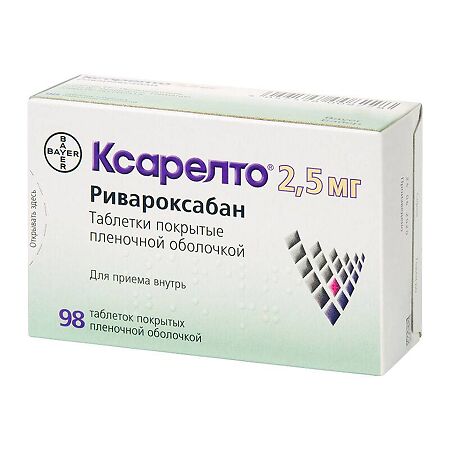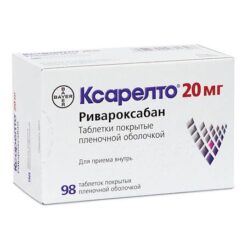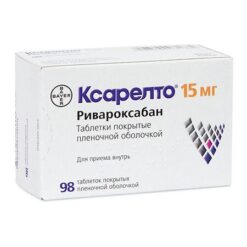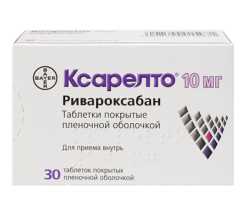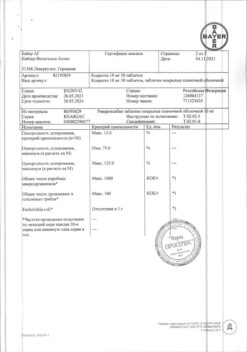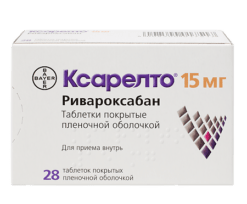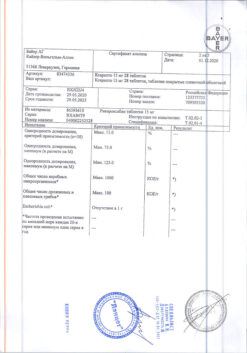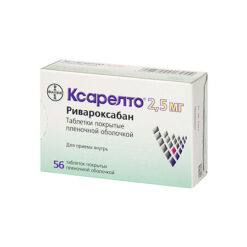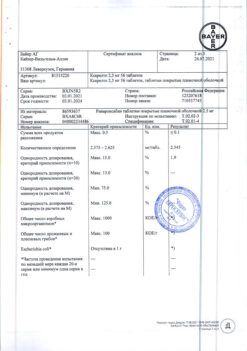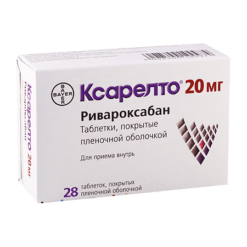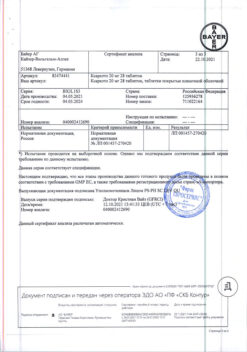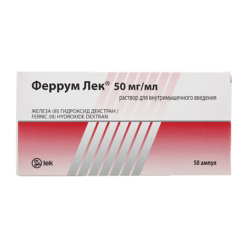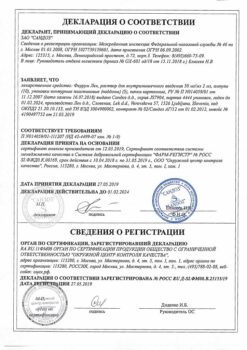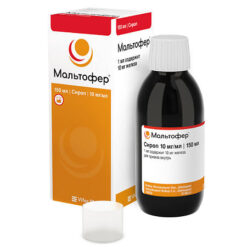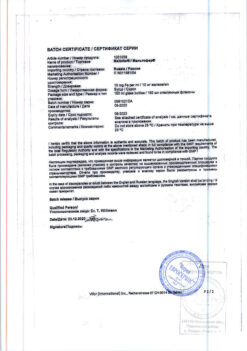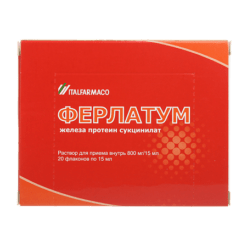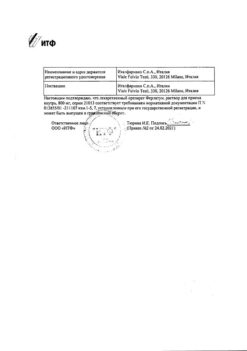No products in the cart.
Xarelto, 2,5mg 98 pcs
€168.42 €140.35
Description
Pharmacotherapeutic group: direct factor Xa inhibitors.
ATC code: B01AR01.
Pharmacological properties
Pharmacodynamics
Mechanism of action
Rivaroxaban is a highly selective direct factor Xa inhibitor with high bioavailability when ingested.
Activation of factor X to form factor Xa through the internal and external coagulation pathways plays a central role in the coagulation cascade. Factor Xa is a component of the forming prothrombinase complex, the action of which leads to the conversion of prothrombin to thrombin. As a result, these reactions lead to the formation of fibrin thrombus and platelet activation by thrombin. One molecule of factor Xa catalyzes the formation of more than 1,000 molecules of thrombin, which has been called the “thrombin explosion.”
The reaction rate of factor Xa bound in prothrombinase increases 300,000 times that of free factor Xa, which provides a sharp spike in thrombin levels. Selective factor Xa inhibitors can stop the thrombin burst. Thus, rivaroxaban affects the results of some specific or general laboratory tests used to evaluate clotting systems.
Pharmacodynamic Effects
In humans, there is a dose-dependent inhibition of factor Xa activity. Rivaroxaban has a dose-dependent effect on the change in prothrombin time, which correlates closely with the plasma concentration of rivaroxaban (correlation coefficient 0.98) if the Neoplastin kit is used for the analysis. Results will be different if other reagents are used. Prothrombin time should be measured in seconds because the INR (international normalized ratio) is calibrated and certified only for coumarin derivatives and cannot be used for other anticoagulants. In patients undergoing major orthopedic surgery, 5/95 percentile values for prothrombin time (Neoplastin) 2-4 hours after taking the tablet (i.e., at maximum effect) range from 13 to 25 seconds.
Also, rivaroxaban dose-dependently increases the activated partial thromboplastin time (APT) and HepTest result; however, these parameters are not recommended for evaluating the pharmacodynamic effects of rivaroxaban. Monitoring of clotting parameters is not required during treatment with Xarelto®. However, if clinically justified, rivaroxaban concentrations may be measured using a calibrated quantitative anti-factor Xa test.
In healthy men and women over 50 years old no prolongation of the electrocardiogram QT interval was observed under the influence of rivaroxaban.
Pharmacokinetics
Absorption and bioavailability
Rivaroxaban is rapidly absorbed; maximum concentration (Cmax) is reached 2-4 hours after tablet administration.
After oral administration, rivaroxaban is almost completely absorbed and its bioavailability with 2.5 mg tablets is high (80-100%) regardless of food intake. Food intake has no effect on AUC (area under the curve “concentration – time”) and Stache at a dose of 10 mg. Xarelto® tablets in 2.5 mg dose can be taken both with food and on an empty stomach (see section “Dosage and administration”). The pharmacokinetics of rivaroxaban are characterized by moderate interindividual variability, with a Cv% coefficient of variability ranging from 30% to 40%.
Absorption of rivaroxaban depends on the site of release in the gastrointestinal tract (GIT). A 29% and 56% reduction in AUC and Cmax, respectively, compared with whole tablet administration was observed when rivaroxaban pellet was administered to the proximal small intestine. Exposure to the drug is also reduced when administered into the distal small intestine or the ascending colon. Administration of rivaroxaban in the gastrointestinal tract distal to the stomach should be avoided because it may result in reduced absorption and, consequently, exposure to the drug.
The bioavailability (AUC and Cmax) of rivaroxaban 20 mg when taken as a whole tablet is comparable to the bioavailability of the drug taken orally as a crushed tablet (mixed with apple puree or suspended in water) and the bioavailability of the drug when given via gastric tube followed by liquid food. Given the predictable dose-dependent pharmacokinetic profile of rivaroxaban, the results of this bioavailability study are also applicable to lower doses.
Distribution
Rivaroxaban has a high degree of binding to plasma proteins, it is approximately 92 to 95%, with rivaroxaban primarily binding to serum albumin. The drug has an average volume of distribution, it is approximately 50 L.
Metabolism and excretion
When administered orally, approximately 2/3 of the dose of rivaroxaban is metabolized and excreted by the kidneys and through the intestine in equal proportions.
The remaining 1/3 of the dose received is excreted via direct renal excretion unchanged, primarily through active renal secretion. Rivaroxaban is metabolized by CYP3A4, CYP2J2 isoenzymes as well as by mechanisms independent of the cytochrome system. The main sites of biotransformation are oxidation of the morpholine group and hydrolysis of amide bonds.
According to in vitro data, rivaroxaban is a substrate for P-gp (P-glycoprotein) and Bcrp (breast cancer resistance protein) messenger proteins. Unchanged rivaroxaban is the only active compound in plasma; no major or active circulating metabolites were detected in plasma. Rivaroxaban, which has a systemic clearance of approximately 10 L/h, may be classified as a low clearance drug. The plasma elimination of rivaroxaban has a final half-life of 5 to 9 hours in young patients and 11 to 13 hours in elderly patients.
Gender/Elderly Age (older than 65 years)
Elderly patients have higher plasma concentrations of rivaroxaban than younger patients; the average AUC is approximately 1.5 times that of younger patients, primarily due to seemingly lower total and renal clearance (see section “Dosage and administration”). No clinically significant differences in pharmacokinetics were found in men and women (see section “Dosage and administration”).
Body weight
Too little or too much body weight (less than 50 kg and more than 120 kg) only slightly affects the plasma concentration of rivaroxaban (difference is less than 25%) (see section “Dosage and administration”).
Childhood and adolescence (birth to 18 years)
No data are available for this age group (see section “Administration and Doses”).
Interethnic differences
No clinically significant differences in pharmacokinetics and pharmacodynamics were observed in patients of Caucasian, African American, Hispanic, Japanese, or Chinese ethnicity (see “Dosage and administration” section).
Hepatic impairment
The effect of hepatic impairment on the pharmacokinetics of rivaroxaban has been studied in patients allocated according to the Child-Pugh classification (according to standard procedures in clinical trials). The Child-Pugh classification provides an assessment of prognosis for patients with chronic liver disease, primarily cirrhosis. For patients scheduled for anticoagulant therapy, the most important consequence of impaired liver function is decreased synthesis of blood clotting factors in the liver.
Because this score meets only one of the five clinical/biochemical criteria that make up the Child-Pugh classification, the risk of bleeding does not correlate clearly with this classification. Treatment of such patients with anticoagulants should be decided irrespective of the Child-Pugh classification. Rivaroxaban is contraindicated in patients with hepatic disease with coagulopathy that is clinically significant bleeding risk. Pharmacokinetics of rivaroxaban in patients with cirrhosis and mild hepatic impairment (Child-Pugh class A) did not significantly differ from those in control group of healthy volunteers (on average there was 1.2 times AUC increase of rivaroxaban). There were no significant differences of pharmacodynamic properties between the groups.
In patients with liver cirrhosis and hepatic insufficiency of the average degree of severity (B class according to Child-Pugh) the average AUC of rivaroxaban was significantly increased (2.3 times) comparing to healthy volunteers due to the significantly decreased clearance of the medicine substance that indicates a serious liver disease. Suppression of factor Xa activity was more pronounced (2.6-fold) than in healthy volunteers. Prothrombin time was also 2.1 times that of healthy volunteers.
The prothrombin time measurement assesses the external coagulation pathway, which includes clotting factors VII, X, V, II and I that are synthesized in the liver. Patients with moderate hepatic insufficiency are more sensitive to rivaroxaban, which is a consequence of the closer relationship between pharmacodynamic effects and pharmacokinetic parameters, especially between concentration and prothrombin time.
No data are available for patients with Child-Pugh class C hepatic insufficiency.
Renal dysfunction
An increase in the area under the concentration-time curve of rivaroxaban was observed in patients with impaired renal function, which was inversely proportional to the degree of decrease in renal function as assessed by creatinine clearance.
. Patients with mild renal impairment (creatinine CLKR clearance 50 -80 ml/min), moderate renal impairment (creatinine CLKR clearance 30 -49 ml/min) or severe renal impairment (creatinine CLKR clearance 15-29 ml/min) showed 1.4-, 1.5- and 1.6-fold increases in rivaroxaban plasma concentrations (AUC), compared to healthy volunteers, respectively (see
The corresponding increase in pharmacodynamic effects was more pronounced. In patients with mild, moderate and severe renal dysfunction the total suppression of factor Xa activity was increased by 1.5, 1.9 and 2 times compared to healthy volunteers; prothrombin time due to factor Xa action was also prolonged by 1.3, 2.2 and 2.4 times, respectively.
There are no data on the use of Xarelto® in patients with CLKr<15ml/min, therefore it is not recommended to use the drug in this category of patients. There are limited data on the use of Xarelto® in patients with CLR 15-29 ml/min; therefore, caution should be exercised when using the drug in this category of patients. (
Due to the underlying disease, patients with severe renal impairment are at increased risk of bleeding and thrombosis.
Indications
Indications
Prevention of death due to cardiovascular causes, myocardial infarction and stent thrombosis in patients after acute coronary syndrome (ACS), which occurred with an increase in cardiac-specific biomarkers, in combination therapy with acetylsalicylic acid or with acetylsalicylic acid and thienopyridines – clopidogrel or ticlopidine.
Prevention of stroke, myocardial infarction and death due to cardiovascular causes, as well as prevention of acute limb ischemia and all-cause mortality in patients with coronary heart disease (CHD) or peripheral arterial disease (PAD) in combination therapy with acetylsalicylic acid.
Pharmacological effect
Pharmacological effect
Pharmacotherapeutic group: direct factor Xa inhibitors.
ATX code: B01AP01.
Pharmacological properties
Pharmacodynamics
Mechanism of action
Rivaroxaban is a highly selective direct factor Xa inhibitor with high oral bioavailability.
Activation of factor X to form factor Xa through the intrinsic and extrinsic coagulation pathways plays a central role in the coagulation cascade. Factor Xa is a component of the developing prothrombinase complex, the action of which leads to the conversion of prothrombin to thrombin. As a result, these reactions lead to the formation of a fibrin thrombus and activation of platelets by thrombin. One molecule of factor Xa catalyzes the formation of more than 1000 molecules of thrombin, which is called the “thrombin burst”.
The rate of reaction of factor Xa bound in prothrombinase is increased 300,000 times compared to that of free factor Xa, which provides a sharp jump in thrombin levels. Selective factor Xa inhibitors can stop the thrombin burst. Therefore, rivaroxaban may interfere with the results of some specific or general laboratory tests used to evaluate coagulation systems.
Pharmacodynamic effects
In humans, dose-dependent inhibition of factor Xa activity is observed. Rivaroxaban has a dose-dependent effect on the change in prothrombin time, which is closely correlated with rivaroxaban plasma concentrations (correlation coefficient 0.98) when the Neoplastin kit is used for analysis. Results will vary if other reagents are used. Prothrombin time should be measured in seconds because the INR (International Normalized Ratio) is calibrated and certified only for coumarin derivatives and cannot be used for other anticoagulants. In patients undergoing major orthopedic surgery, the 5/95 percentile values for prothrombin time (Neoplastin) 2 to 4 hours after tablet administration (i.e., at maximum effect) range from 13 to 25 seconds.
Also, rivaroxaban dose-dependently increases activated partial thromboplastin time (aPTT) and HepTest result; however, these parameters are not recommended for assessing the pharmacodynamic effects of rivaroxaban. During treatment with Xarelto®, monitoring of blood coagulation parameters is not required. However, if clinically warranted, rivaroxaban concentrations can be measured using a calibrated quantitative anti-factor Xa test.
In healthy men and women over 50 years of age, prolongation of the electrocardiogram QT interval under the influence of rivaroxaban was not observed.
Pharmacokinetics
Absorption and bioavailability
Rivaroxaban is rapidly absorbed; the maximum concentration (Cmax) is achieved 2-4 hours after taking the tablet.
After oral administration, rivaroxaban is absorbed almost completely and its bioavailability when taking 2.5 mg tablets is high (80-100%), regardless of food intake. Food intake has no effect on AUC (area under the concentration-time curve) and Cmax when taking a dose of 10 mg. Xarelto® tablets at a dosage of 2.5 mg can be taken with food or on an empty stomach (see section “Dosage and Administration”). The pharmacokinetics of rivaroxaban is characterized by moderate interindividual variability, the coefficient of variability Cv% ranges from 30% to 40%.
The absorption of rivaroxaban depends on the site of release in the gastrointestinal (GI) tract. Reductions of 29% and 56% in AUC and Cmax, respectively, compared with whole tablet administration, were observed when rivaroxaban granulate was administered into the proximal small intestine. Drug exposure is also reduced when administered into the distal small intestine or ascending colon. Administration of rivaroxaban into the gastrointestinal tract distal to the stomach should be avoided as this may result in decreased absorption and therefore decreased exposure of the drug.
The bioavailability (AUC and Cmax) of rivaroxaban 20 mg when taken as a whole tablet is comparable to the bioavailability of the drug taken orally as a crushed tablet (mixed with applesauce or suspended in water), as well as the bioavailability of the drug when administered through a gastric tube followed by a liquid diet. Given the predictable dose-dependent pharmacokinetic profile of rivaroxaban, the results of this bioavailability study also apply to lower doses.
Distribution
Rivaroxaban has a high degree of binding to plasma proteins, it is approximately 92 – 95%, mainly rivaroxaban binds to serum albumin. The drug has an average volume of distribution, it is approximately 50 l.
Metabolism and excretion
When taken orally, approximately 2/3 of the received dose of rivaroxaban is metabolized and excreted by the kidneys and intestines in equal proportions.
The remaining 1/3 of the dose received is excreted unchanged by direct renal excretion, mainly due to active renal secretion. Rivaroxaban is metabolized through isoenzymes CYP3A4, CYP2J2, as well as through mechanisms independent of the cytochrome system. The main sites of biotransformation are the oxidation of the morpholine group and the hydrolysis of amide bonds.
According to in vitro data, rivaroxaban is a substrate for the transport proteins P-gp (P-glycoprotein) and Bcrp (breast cancer resistance protein). Unchanged rivaroxaban is the only active compound in plasma; no major or active circulating metabolites have been detected in plasma. Rivaroxaban, whose systemic clearance is approximately 10 L/h, can be classified as a drug with low clearance. When rivaroxaban is eliminated from plasma, the terminal half-life is 5 to 9 hours in younger patients and 11 to 13 hours in older patients.
Gender/Old age (over 65 years old)
Elderly patients have higher plasma concentrations of rivaroxaban than younger patients; the average AUC value is approximately 1.5 times higher than the corresponding values in young patients, mainly due to an apparent decrease in total and renal clearance (see section “Dosage and Administration”). No clinically significant differences in pharmacokinetics were found in men and women (see section “Dosage and Administration”).
Body weight
Too little or too much body weight (less than 50 kg and more than 120 kg) only slightly affects the concentration of rivaroxaban in the blood plasma (the difference is less than 25%) (see section “Dosage and Administration”).
Childhood and adolescence (from birth to 18 years)
There are no data for this age category (see section “Dosage and Administration”).
Interethnic differences
No clinically significant differences in pharmacokinetics and pharmacodynamics were observed in patients of Caucasian, African American, Hispanic, Japanese or Chinese ethnicity (see section “Dosage and Administration”).
Liver dysfunction
The effect of hepatic impairment on the pharmacokinetics of rivaroxaban was studied in patients allocated according to the Child-Pugh classification (according to standard procedures in clinical trials). The Child-Pugh classification allows one to assess the prognosis for patients with chronic liver diseases, mainly cirrhosis. For patients undergoing anticoagulant therapy, the most important consequence of impaired liver function is a decrease in the synthesis of coagulation factors in the liver.
Since this indicator corresponds to only one of the five clinical/biochemical criteria that make up the Child-Pugh classification, the risk of bleeding does not clearly correlate with this classification. The question of treating such patients with anticoagulants should be decided regardless of the Child-Pugh class. Rivaroxaban is contraindicated in patients with liver disease associated with coagulopathy causing a clinically significant risk of bleeding. In patients with liver cirrhosis and mild liver failure (Child-Pugh class A), the pharmacokinetics of rivaroxaban differed only slightly from the corresponding indicators in the control group of healthy volunteers (on average, there was an increase in the AUC of rivaroxaban by 1.2 times). There were no significant differences in pharmacodynamic properties between groups.
In patients with cirrhosis and moderate hepatic impairment (Child-Pugh class B), the mean AUC of rivaroxaban was significantly increased (2.3-fold) compared to healthy volunteers due to significantly reduced drug clearance, indicating significant liver disease. The suppression of factor Xa activity was more pronounced (2.6 times) than in healthy volunteers. Prothrombin time was also 2.1 times higher than in healthy volunteers.
By measuring prothrombin time, the extrinsic coagulation pathway is assessed, including coagulation factors VII, X, V, II and I, which are synthesized in the liver. Patients with moderate hepatic impairment are more sensitive to rivaroxaban, which is a consequence of a closer relationship between pharmacodynamic effects and pharmacokinetic parameters, especially between concentration and prothrombin time.
There are no data available for patients with Child-Pugh Class C hepatic impairment.
Renal dysfunction
In patients with impaired renal function, an increase in the area under the concentration-time curve of rivaroxaban was observed, inversely proportional to the degree of decrease in renal function, as assessed by creatinine clearance.
In patients with mild renal impairment (CrCl creatinine clearance 50-80 ml/min), moderate renal impairment (CrCl creatinine clearance 30-49 ml/min) or severe renal impairment (CrCl creatinine clearance 15-29 ml/min), a 1.4-, 1.5- and 1.6-fold increase in concentrations was observed, respectively. rivaroxaban in blood plasma (AUC), compared with healthy volunteers (see sections “Dosage and Administration”, “Special Instructions”, “Precautions”).
The corresponding increase in pharmacodynamic effects was more pronounced. In patients with mild, moderate and severe renal impairment, the overall suppression of factor Xa activity increased by 1.5, 1.9 and 2 times compared with healthy volunteers; prothrombin time due to the action of factor Xa was also prolonged by 1.3, 2.2 and 2.4 times, respectively.
There are no data on the use of Xarelto® in patients with ClCr < 15 ml/min, and therefore it is not recommended to use the drug in this category of patients. Data on the use of Xarelto® in patients with CrCl 15-29 ml/min are limited, and therefore caution should be exercised when using the drug in this category of patients. (see sections “Method of administration and dosage”, “Special instructions”, “With caution”)Due to the underlying disease, patients with severe renal impairment are at increased risk of bleeding and thrombosis.
Special instructions
Special instructions
Use of concomitant medications
Rivaroxaban is not recommended for use in patients receiving concomitant systemic treatment with azole antifungals (eg, ketoconazole) or HIV protease inhibitors (eg, ritonavir). These drugs are potent inhibitors of CYP3A4 and P-glycoprotein. Therefore, these drugs may increase plasma concentrations of rivaroxaban to clinically significant levels (2.6-fold on average), which may lead to an increased risk of bleeding (see Interactions with Other Drugs section). However, the azole antifungal drug fluconazole, a moderate inhibitor of CYP3A4, has a less pronounced effect on the exposure of rivaroxaban and can be used concomitantly with it (see section “Interactions with other medicinal products”).
Renal dysfunction
Rivaroxaban should be used with caution in patients with moderate renal impairment (CrCl 30-49 ml/min) receiving concomitant medications that may lead to increased plasma concentrations of rivaroxaban (see section “Interactions with other drugs”).
In patients with severe renal impairment (CrCl < 30 ml/min), plasma concentrations of rivaroxaban may be significantly increased (1.6-fold on average), which may lead to an increased risk of bleeding. Therefore, due to the presence of this underlying disease, such patients have an increased risk of developing both bleeding and thrombosis. Due to the limited amount of clinical data, rivaroxaban should be used with caution in patients with CrCl 15-29 ml/min.
There are no clinical data on the use of rivaroxaban in patients with severe renal impairment (CrCl < 15 ml/min). Therefore, rivaroxaban is not recommended for use in such patients (see sections "Method of administration and dosage", "Pharmacological properties").
Patients with severe renal impairment (CrCl 15-29 mL/min) or increased risk of bleeding, as well as patients receiving concomitant systemic treatment with azole antifungals or HIV protease inhibitors, should be closely monitored for signs of bleeding after initiation of treatment. Monitoring can be carried out by conducting regular physical examinations of patients, carefully monitoring the state of postoperative wound drainage, and also by periodically determining hemoglobin.
Patients with a history of stroke and/or TIA
Xarelto® 2.5 mg twice daily is contraindicated in patients with ACS who have a history of stroke or TIA. Only a few patients with ACS with a history of stroke or TIA have been studied, but the limited data obtained demonstrate a lack of clinical benefit from treatment with rivaroxaban in these patients.
Patients with hemorrhagic or lacunar stroke
Patients with CAD or PAD with a history of hemorrhagic or lacunar stroke were not studied. Such patients are contraindicated in treatment with Xarelto® 2.5 mg twice daily in combination with acetylsalicylic acid.
Patients with ischemic nonlacunar stroke
Patients with CAD or PAD who had an ischemic nonlacunar stroke within the previous month were not studied. Such patients are contraindicated in treatment with Xarelto® 2.5 mg twice daily in combination with acetylsalicylic acid during the first month after stroke.
Risk of bleeding
Xarelto®, like other antithrombotic agents, should be used with caution in patients with an increased risk of bleeding, such as:
congenital or acquired coagulation disorders
uncontrolled severe hypertension
active gastrointestinal pathology with ulceration
recent acute ulcer in the gastrointestinal tract
vascular retinopathy
recent intracranial or intracerebral hemorrhage
intraspinal or intracerebral vascular abnormalities
recent brain, spinal cord, or eye surgery
history of bronchiectasis or episode of pulmonary hemorrhage
Caution should be exercised if the patient is concomitantly receiving medications that affect hemostasis, such as nonsteroidal anti-inflammatory drugs (NSAIDs), platelet aggregation inhibitors, other antithrombotic drugs or selective serotonin reuptake inhibitors (SSRIs) and selective serotonin norepinephrine reuptake inhibitors (SNRIs) (see section “Interactions with other drugs”).
Active ingredient
Active ingredient
Rivaroxaban
Composition
Composition
1 film-coated tablet contains:
active ingredient:
rivaroxaban micronized 2.50 mg,
excipients:
microcrystalline cellulose – 40.00 mg,
croscarmellose sodium – 3.00 mg,
hypromellose 5cP -3.00 mg,
lactose monohydrate – 35.70 mg,
magnesium stearate – 0.60 mg,
sodium lauryl sulfate – 0.20 mg;
shell:
iron oxide yellow dye – 0.015 mg,
hypromellose 15cP – 1,500 mg,
macrogol 3350 – 0.500 mg,
titanium dioxide – 0.485 mg.
Pregnancy
Pregnancy
Pregnancy
The safety and effectiveness of rivaroxaban in pregnant women have not been established. Data obtained in experimental animals have shown pronounced maternal toxicity of rivaroxaban, associated with the pharmacological action of the drug (for example, complications in the form of hemorrhages) and leading to reproductive toxicity. No primary teratogenic potential was detected.
Due to the possible risk of bleeding and the ability to cross the placenta, rivaroxaban is contraindicated during pregnancy (see section “Contraindications”).
Women with preserved reproductive capacity should use effective methods of contraception during treatment with rivaroxaban.
Breastfeeding
There are no data on the use of Xarelto® for the treatment of women during breastfeeding. Data obtained in experimental animals show that rivaroxaban is excreted in breast milk. Xarelto® can only be used after breastfeeding has stopped (see section “Contraindications”).
Contraindications
Contraindications
Hypersensitivity to rivaroxaban or any excipient included in the drug.
Clinically significant active bleeding (eg, intracranial hemorrhage, gastrointestinal bleeding).
Liver diseases occurring with coagulopathy leading to a clinically significant risk of bleeding, including cirrhosis and impaired liver function of class B and C according to the Child-Pugh classification (see section “Pharmacological properties”).
Pregnancy and breastfeeding (see section “Use during pregnancy and breastfeeding”).
Children and adolescents up to 18 years of age (efficacy and safety for patients in this age group have not been established).
Severe renal impairment (CrCl < 15 ml/min) (there are no clinical data on the use of rivaroxaban in this category of patients).
Treatment of ACS with antiplatelet agents in patients who have suffered a stroke or transient ischemic attack.
Concomitant therapy with any other anticoagulants, for example, unfractionated heparin, low molecular weight heparins (enoxaparin, dalteparin, etc.), heparin derivatives (fondaparinux, etc.), oral anticoagulants (warfarin, apixaban, dabigatran, etc.), except in cases of switching from or to rivaroxaban (see section “Method of administration and dose") or when using unfractionated heparin in doses necessary to ensure the functioning of a central venous or arterial catheter.
Hereditary lactose or galactose intolerance (for example, congenital lactase deficiency or glucose-galactose malabsorption), since this medicinal product contains lactose.
With caution
The drug should be used with caution:
In the treatment of patients with an increased risk of bleeding (including congenital or acquired tendency to bleeding, uncontrolled severe arterial hypertension, gastric and duodenal ulcers in the acute stage, recent acute gastric and duodenal ulcers, vascular retinopathy, recent intracranial or intracerebral hemorrhage, in the presence of known anomalies of the spinal or cerebral vessels brain, after recent surgery on the brain, spinal cord or eyes, with a history of bronchiectasis or pulmonary hemorrhage).
In the treatment of patients with moderate renal impairment (CrCl 3049 ml/min) who are simultaneously receiving drugs that increase the concentration of rivaroxaban in the blood plasma (see section “Interaction with other drugs”).
When treating patients with severe renal impairment (ClCr 15 -29 ml/min) (see section “Special Instructions”).
In patients receiving concomitant medications that affect hemostasis, such as nonsteroidal anti-inflammatory drugs (NSAIDs), antiplatelet agents, other antithrombotics or selective serotonin reuptake inhibitors (SSRIs) and selective serotonin norepinephrine reuptake inhibitors (SNRIs).
Rivaroxaban is not recommended for use in patients receiving systemic treatment with azole antifungals (for example, ketoconazole, itraconazole, voriconazole and posaconazole) or HIV protease inhibitors (for example, ritonavir). (See sections “Interaction with other drugs”, “Special instructions”).
Patients with severe renal impairment (CrCl 15-29 ml/min) or an increased risk of bleeding and patients receiving concomitant systemic treatment with azole antifungals or HIV protease inhibitors should be closely monitored after initiation of treatment for timely detection of bleeding complications.
Side Effects
Side Effects
The safety of Xarelto® was assessed in thirteen phase III studies involving 53,103 patients treated with Xarelto®.
Table 1: Number of patients enrolled in the study who took at least 1 dose of rivaroxaban, total daily dose and maximum duration of treatment in phase III clinical studies using Xarelto®
Therapeutic area
Number of patients*
Total daily dose
Maximum duration of treatment
Prevention of venous thromboembolism (VTE) in patients undergoing elective hip or knee replacement surgery.
6,097
10 mg
39 days
Prevention of venous thromboembolism in patients hospitalized for medical reasons.
3,997
10 mg
39 days
Treatment of DVT, PE and prevention of recurrence of DVT, PE.
6,790
Day 1 – 21: 30 mg
From day 22: 20 mg
After at least 6 months of therapy: 10 mg or 20 mg
21 months
Prevention of stroke and systemic thromboembolism in patients with non-valvular atrial fibrillation.
7 750
20 mg
41 months
Prevention of atherothrombotic events in patients after ACS.
10 225
5 mg or 10 mg respectively, in combination with acetylsalicylic acid or acetylsalicylic acid with clopidogrel or ticlopidine
31 months
Prevention of stroke, myocardial infarction and death due to cardiovascular causes, as well as for the prevention of acute limb ischemia and all-cause mortality in patients with coronary artery disease or PAD.
18,244
5 mg in combination with acetylsalicylic acid 100 mg or 10 mg in monotherapy
47 months
*Patients who have received at least one dose of rivaroxaban.
Table 2: Incidence of bleeding and anemia in patients treated with Xarelto® from phase III studies
Therapeutic area
Any bleeding
Anemia
Prevention of VTE in patients undergoing elective hip or knee replacement surgery.
6.8% of patients
5.9% of patients
Prevention of venous thromboembolism in patients hospitalized for medical reasons.
12.6% of patients
2.1% of patients
Treatment of DVT, PE and prevention of recurrence of DVT, PE.
23% of patients
1.6% of patients
Prevention of stroke and systemic thromboembolism in patients with non-valvular atrial fibrillation.
28 events per 100 patient-years
2.5 events per 100 patient-years
Prevention of atherothrombotic events in patients after ACS.
22 events per 100 patient-years
1.4 events per 100 patient-years
Prevention of stroke, myocardial infarction and death due to cardiovascular causes, as well as for the prevention of acute limb ischemia and all-cause mortality in patients with coronary artery disease or PAD.
6.7 events per 100 patient-years
0.15 events per 100 patient-years*
* A prespecified sampling approach was used to collect data on adverse events
Considering the mechanism of action, the use of Xarelto® may be associated with an increased risk of latent or obvious bleeding from any tissues and organs, which can lead to the development of posthemorrhagic anemia. The risk of bleeding may increase in patients with severe uncontrolled arterial hypertension and/or when used together with drugs that affect hemostasis (see section “Precautions”).
Signs, symptoms and severity (including possible death) will vary depending on the source and extent or severity of bleeding and/or anemia (see Overdose section).
Hemorrhagic complications may include weakness, pallor, dizziness, headache, or unexplained swelling, shortness of breath, or shock that cannot be explained by other causes. In some cases, as a consequence of anemia, symptoms of myocardial ischemia, such as chest pain or angina, are observed.
Known complications secondary to severe bleeding, such as increased subfascial pressure syndrome (compartment syndrome) and renal failure due to hypoperfusion, have also been reported with the use of Xarelto®. Therefore, when assessing the condition of any patient receiving anticoagulants, the possibility of bleeding should be considered.
The incidence of ADRs (adverse drug reactions) when using Xarelto® is shown in the table below. Within each frequency group, adverse events are presented in order of decreasing severity.
Frequency of occurrence is defined as:
very often (>1/10),
often (>1/100 to <1/10),
uncommon (>1/1,000 to <1/100),
rare (>1/10,000 to <1/1,000).
Table 3: All treatment-emergent adverse drug reactions reported in patients in phase III clinical trials (cumulative data from RECORD 1-4, ROCKET AF, J-ROCKET, MAGELLAN, ATLAS, EINSTEIN (DVT/PE/Extension/CHOICE) and COMPASS*)
System-organ class (MedDRA – Medical Dictionary of Regulatory Lexicon version 20.0)
Often
Uncommon
Rarely
Blood and lymphatic system disorders
Anemia (including relevant laboratory values)
Thrombocytosis (including increased platelet count)A
Immune system disorders
Allergic reaction, allergic dermatitis
Nervous system disorders
Dizziness, headache
Intracerebral and intracranial hemorrhages, syncope
Visual disorders
Hemorrhage into the eye (including hemorrhage into the conjunctiva)
Heart disorders
Tachycardia
Vascular disorders
Decreased blood pressure, hematoma
Disorders of the chest and mediastinum
Nasal respiratory system, bleeding, hemoptysis
Gastrointestinal disorders
Bleeding gums, gastrointestinal bleeding (including rectal bleeding), gastrointestinal and abdominal pain, dyspepsia, nausea, constipationA, diarrhea, vomitingA
Dry mouth
Disorders of the liver and biliary tract
Liver dysfunction
Jaundice
Skin and subcutaneous tissue disorders
Pruritus (including rare cases of generalized pruritus), skin rash, ecchymosis, cutaneous and subcutaneous hemorrhages
Hives
Musculoskeletal and connective tissue disorders
Pain in limbsA
Hemarthrosis
Bleeding into a muscle
Renal and urinary tract disorders
Bleeding from the urogenital tract (including hematuria and menorrhagiaB), impaired renal function (including increased blood creatinine concentrations, increased blood urea concentrations)A
General and administration site disorders
FeverA, peripheral edema, decreased overall muscle strength and tone (including weakness and asthenia)
Deterioration in general health (including malaise)
Local edema
Laboratory and instrumental data
Increased activity of liver transaminases
Increased bilirubin concentration, increased alkaline phosphatase A activity, increased LDGA activity, increased lipase A activity, increased amylase A activity, increased GGTA activity
Increased concentration of conjugated bilirubin (with or without a corresponding increase in ALT activity)
Injuries, intoxications and complications of manipulations
Bleeding after medical manipulation (including postoperative anemia and bleeding from a wound), bruise
Secretion from a woundA
Vascular pseudoaneurysmC
And they were observed mainly after major orthopedic operations on the lower extremities
B observed in the treatment of VTE as very common in women aged < 55 years
C were observed as infrequent as part of the prevention of complications in ACS (after percutaneous interventions).
*A prespecified selective approach was used to collect data on adverse events. Because the incidence of adverse drug reactions did not increase, and because no new adverse drug reactions were identified, data from the COMPASS study were not included to calculate the incidence in this table.
The most common adverse reactions in patients using the drug were bleeding. The most common bleeding events (>4%) were epistaxis (5.9%) and gastrointestinal bleeding (4.2%).
During post-marketing monitoring, cases of the following adverse reactions were reported, the development of which had a temporary connection with taking Xarelto®. It is not possible to assess the frequency of occurrence of such adverse reactions within the framework of post-registration monitoring.
Immune system disorders: angioedema, allergic edema. In phase III registration clinical trials (RCTs), such adverse reactions were considered uncommon (from >1/1000 to <1/100).Disorders of the liver and biliary tract: cholestasis, hepatitis (including hepatocellular damage). In the phase III RCT, such adverse reactions were considered rare (>1/10,000 to <1/1,000).Blood and lymphatic system disorders: thrombocytopenia. In the phase III RCT, such adverse reactions were considered infrequent (>1/1000 to <1/100).
Interaction
Interaction
Pharmacokinetic interactions
Rivaroxaban is primarily eliminated via cytochrome P450 (CYP 3A4, CYP 2J2)-mediated hepatic metabolism and renal excretion of unchanged drug via the P-glycoprotein (P-gp)/BCRP (breast cancer resistance protein) transport protein system.
Caution should be exercised when rivaroxaban is used concomitantly with dronedarone due to limited clinical data on concomitant use.
CYP inhibition
Rivaroxaban does not inhibit CYP 3A4 or any other major CYP isoforms.
CYP induction
Rivaroxaban does not induce CYP 3A4 or any other major CYP isoforms.
Effect on rivaroxaban
Concomitant use of rivaroxaban with strong CYP3A4 and P-gp inhibitors may result in decreased hepatic and renal clearance, thereby significantly increasing systemic exposure.
Concomitant use of rivaroxaban with the azole antifungal drug ketoconazole (400 mg once daily), a potent inhibitor of CYP 3A4 and P-gp, resulted in a 2.6-fold increase in the mean steady-state AUC and a 1.7-fold increase in the mean Cmax of rivaroxaban, with a significant increase in the pharmacodynamic effects of this drug.
Concomitant use of rivaroxaban with the HIV protease inhibitor ritonavir (600 mg twice daily), a potent inhibitor of CYP 3A4 and P-gp, resulted in a 2.5-fold increase in the mean AUC and a 1.6-fold increase in the mean Cmax of rivaroxaban, with a significant increase in the pharmacodynamic effects of this drug. Therefore, rivaroxaban is not recommended for use in patients receiving concomitant systemic treatment with azole antifungals or HIV protease inhibitors (see sections “Precautions”, “Special Instructions”). Other active substances that inhibit at least one of the pathways of rivaroxaban elimination, mediated by either CYP3A4 or P-gp, are likely to increase plasma concentrations of rivaroxaban to a lesser extent.
Overdose
Overdose
Rare cases of overdose up to 600 mg without bleeding or other adverse events have been reported. Due to limited absorption, plateau concentrations are expected without further increases in mean plasma concentrations of rivaroxaban when supratherapeutic doses of 50 mg or higher are used.
There is no specific antidote that counteracts the pharmacodynamic effects of rivaroxaban. In case of an overdose of Xarelto®, activated charcoal can be used to reduce the absorption of the drug. Due to significant plasma protein binding, rivaroxaban is not expected to be eliminated by hemodialysis.
Storage conditions
Storage conditions
At a temperature not exceeding 30°C.
Keep out of the reach of children.
Shelf life
Shelf life
3 years. Do not use after the expiration date stated on the package
Manufacturer
Manufacturer
Bayer AG, Germany
Additional information
| Shelf life | 3 years. Do not use after the expiration date printed on the package |
|---|---|
| Conditions of storage | At a temperature not exceeding 30 ° C. Keep out of reach of children. |
| Manufacturer | Bayer AG, Germany |
| Medication form | pills |
| Brand | Bayer AG |
Other forms…
Related products
Buy Xarelto, 2,5mg 98 pcs with delivery to USA, UK, Europe and over 120 other countries.

